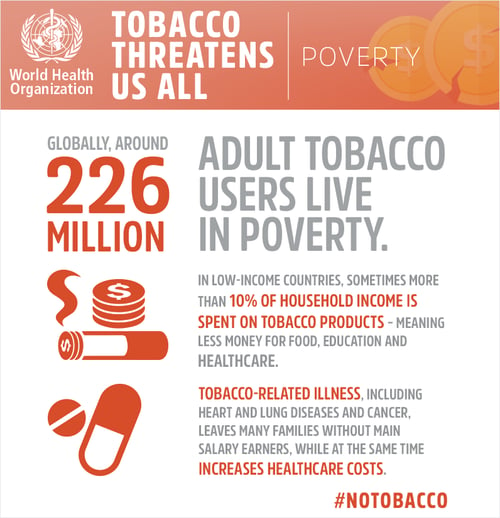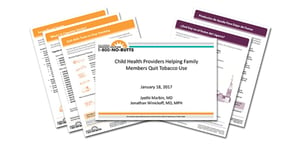30 May 2017 | Geneva - Action to stamp out tobacco use can help countries prevent millions of people falling ill and dying from tobacco-related disease, combat poverty and, according to a first-ever WHO report, reduce large-scale environmental degradation.
On World No Tobacco Day 2017, WHO is highlighting how tobacco threatens the development of nations worldwide, and is calling on governments to implement strong tobacco control measures. These include banning marketing and advertising of tobacco, promoting plain packaging of tobacco products, raising excise taxes, and making indoor public places and workplaces smoke-free.
Tobacco’s health and economic costs
Tobacco use kills more than 7 million people every year and costs households and governments over US$ 1.4 trillion through healthcare expenditure and lost productivity.
"Tobacco threatens us all," says WHO Director-General Dr Margaret Chan. "Tobacco exacerbates poverty, reduces economic productivity, contributes to poor household food choices, and pollutes indoor air."
Dr Chan adds: "But by taking robust tobacco control measures, governments can safeguard their countries' futures by protecting tobacco users and non-users from these deadly products, generating revenues to fund health and other social services, and saving their environments from the ravages tobacco causes."
All countries have committed to the 2030 Agenda for Sustainable Development, which aims to strengthen universal peace and eradicate poverty. Key elements of this agenda include implementing the WHO Framework Convention on Tobacco Control, and by 2030 reducing by one third premature death from noncommunicable diseases (NCDs), including heart and lung diseases, cancer, and diabetes, for which tobacco use is a key risk factor.

Tobacco scars the environment
The first-ever WHO report, Tobacco and its environmental impact: an overview, also shows the impact of this product on nature, including:
- Tobacco waste contains over 7000 toxic chemicals that poison the environment, including human carcinogens.
- Tobacco smoke emissions contribute thousands of tons of human carcinogens, toxicants, and greenhouse gases to the environment. And tobacco waste is the largest type of litter by count globally.
- Up to 10 billion of the 15 billion cigarettes sold daily are disposed in the environment.
- Cigarette butts account for 30–40% of all items collected in coastal and urban clean-ups.
Tobacco threatens women, children, and livelihoods
Tobacco threatens all people, and national and regional development, in many ways, including:
- Poverty: Around 860 million adult smokers live in low- and middle-income countries. Many studies have shown that in the poorest households, spending on tobacco products often represents more than 10% of total household expenditure – meaning less money for food, education and healthcare.
- Children and education: Tobacco farming stops children attending school. 10%–14% of children from tobacco-growing families miss class because of working in tobacco fields.
- Women: 60%–70% of tobacco farm workers are women, putting them in close contact with often hazardous chemicals.
- Health: Tobacco contributes to 16% of all noncommunicable diseases (NCDs) deaths.
For more information, please contact:
Paul Garwood
WHO Department of Communications
Telephone: +41 22 791 15 78
Mobile: +41 79 603 72 94
Email: garwoodp@who.int
Christian Lindmeier
WHO Department of Communications
Telephone: +41 22 791 1948
Mobile: +41 79 500 6552
Email: lindmeierch@who.int






 May is
May is  Smoking cessation groups have been a mainstay of cessation interventions for years, but starting and maintaining groups can sometimes prove challenging. In this webinar Ken Fitzgerald from the Stanislaus County Office of Education and Zoila Reyna, MPH from the American Lung Association will offer insights, tools and resources for getting cessation groups up and running and for keeping them going:
Smoking cessation groups have been a mainstay of cessation interventions for years, but starting and maintaining groups can sometimes prove challenging. In this webinar Ken Fitzgerald from the Stanislaus County Office of Education and Zoila Reyna, MPH from the American Lung Association will offer insights, tools and resources for getting cessation groups up and running and for keeping them going:
 Ken has been coordinating public health and prevention programs in Stanislaus County since 2002. His experience includes leading policy initiatives for smoke-free outdoor areas in parks and colleges He also helped develop the Protecting Health And Slamming Tobacco (PHAST) Youth Coalition, which has grown into one of the largest tobacco prevention youth coalitions in California. Ken led in the development of the tobacco cessation curriculum known as Stop Tobacco And Nicotine Dependence (STAND). He provides training and technical assistance to schools and community organizations to support student wellness and strengthen school climate.
Ken has been coordinating public health and prevention programs in Stanislaus County since 2002. His experience includes leading policy initiatives for smoke-free outdoor areas in parks and colleges He also helped develop the Protecting Health And Slamming Tobacco (PHAST) Youth Coalition, which has grown into one of the largest tobacco prevention youth coalitions in California. Ken led in the development of the tobacco cessation curriculum known as Stop Tobacco And Nicotine Dependence (STAND). He provides training and technical assistance to schools and community organizations to support student wellness and strengthen school climate.  Zoila trains and supports health professionals throughout California in tobacco cessation programs in both clinical and public settings. She received her Master’s Degree in Public Health from UC Davis. She has 10 years of experience in program management, community engagement, and public health programs for underserved populations, in both rural and urban areas.
Zoila trains and supports health professionals throughout California in tobacco cessation programs in both clinical and public settings. She received her Master’s Degree in Public Health from UC Davis. She has 10 years of experience in program management, community engagement, and public health programs for underserved populations, in both rural and urban areas.

 The
The 
 If you missed our webinar on January 18th, you can download our new provider toolkit, Child Health Providers Helping Family Members Quit Tobacco Use.
If you missed our webinar on January 18th, you can download our new provider toolkit, Child Health Providers Helping Family Members Quit Tobacco Use.

